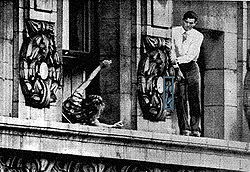
John William Warde
Encyclopedia
John William Warde was a twenty-six-year-old native of Southampton, New York
who committed suicide on July 26, 1938. He leaped from a window ledge of the seventeenth floor of the Gotham Hotel at 5th Avenue and 55th Street in Manhattan
. The son of a Long Island
express agent, his eleven-hour dilemma before jumping held three hundred New York City Police Department
officers at bay. They were afraid of making a move.
Warde earlier had become upset by a remark made by his sister while he was sitting with a group of people in a 17th-floor room of the hotel. He dashed for a window and then occupied the ledge, balancing there from morning until late in the evening.
 Four hundred police officers and NYPD personnel responded to the emergency together with members of the Fire Department
Four hundred police officers and NYPD personnel responded to the emergency together with members of the Fire Department
and volunteer helpers. Psychiatrist J. C. Presner was called by hotel management to make a plea to Warde, who was believed to be clinically depressed. Presner dropped tablets in the water which was being handed to Warde, which he hoped would help a person suffering from melancholia
. Unfortunately the medicine did not work.
Policeman Charles V. Glasco attempted to persuade Warde not to jump by talking to him on and off for hours. They discussed baseball, ping pong and picnics, among other subjects. Glasco eventually stripped off his uniform coat, police shield and pistol belt. He impersonated a bellhop
who proclaimed he would lose his job if Ward jumped.
Warde eventually leaped feet first at 10:38 P.M., crashing into the glass marquee of the 55th Street entrance of the Gotham Hotel. His body smashed to the sidewalk. When he jumped, ten thousand people were gathered at the busy intersection of 55th Street and Fifth Avenue. Collectively they shouted, “Here he comes!” prior to becoming silent at the moment Warde made his plunge.
following a private funeral service at the New York and Brooklyn Funeral Home, located at 187 South Oxford Street in Brooklyn. His parents and two friends were present at the service. The service was pushed ahead four hours from a previously arranged time so as to avoid crowds.
Warde's father, John A. Warde, was found vacationing in Vermont
. The family home where he and Warde's mother resided was located at 25 Willow Street, Southampton.
wrote about the Warde suicide in The New Yorker
, in an article entitled “That Was New York: The Man on the Ledge,” which was published on April 16, 1949. The story was purchased by Twentieth Century Fox.
The Sayre article was adapted by Fox into the 1951 film Fourteen Hours
, with Richard Basehart
as the man on the ledge and Paul Douglas
as the police officer who tries to talk him out of jumping. As originally shot, the film ended as in reality, with the man jumping to his death. After a preview, this was changed to end with him falling accidentally and grabbing the net to save his life.
The studio changed the title from The Man on the Ledge to Fourteen Hours at the request of Warde's mother, so that the picture would not be as closely identified with her son. Studio chief Darryl F. Zanuck
considered changing the setting of the movie to another city for the same reason, but it was ultimately filmed in New York.
Southampton (town), New York
The Town of Southampton is located in southeastern Suffolk County, New York, U.S., partly on the South Fork of Long Island. As of the United States 2000 Census, the town had a total population of 54,712...
who committed suicide on July 26, 1938. He leaped from a window ledge of the seventeenth floor of the Gotham Hotel at 5th Avenue and 55th Street in Manhattan
Manhattan
Manhattan is the oldest and the most densely populated of the five boroughs of New York City. Located primarily on the island of Manhattan at the mouth of the Hudson River, the boundaries of the borough are identical to those of New York County, an original county of the state of New York...
. The son of a Long Island
Long Island
Long Island is an island located in the southeast part of the U.S. state of New York, just east of Manhattan. Stretching northeast into the Atlantic Ocean, Long Island contains four counties, two of which are boroughs of New York City , and two of which are mainly suburban...
express agent, his eleven-hour dilemma before jumping held three hundred New York City Police Department
New York City Police Department
The New York City Police Department , established in 1845, is currently the largest municipal police force in the United States, with primary responsibilities in law enforcement and investigation within the five boroughs of New York City...
officers at bay. They were afraid of making a move.
Warde earlier had become upset by a remark made by his sister while he was sitting with a group of people in a 17th-floor room of the hotel. He dashed for a window and then occupied the ledge, balancing there from morning until late in the evening.
Chronology of death

New York City Fire Department
The New York City Fire Department or the Fire Department of the City of New York has the responsibility for protecting the citizens and property of New York City's five boroughs from fires and fire hazards, providing emergency medical services, technical rescue as well as providing first response...
and volunteer helpers. Psychiatrist J. C. Presner was called by hotel management to make a plea to Warde, who was believed to be clinically depressed. Presner dropped tablets in the water which was being handed to Warde, which he hoped would help a person suffering from melancholia
Melancholia
Melancholia , also lugubriousness, from the Latin lugere, to mourn; moroseness, from the Latin morosus, self-willed, fastidious habit; wistfulness, from old English wist: intent, or saturnine, , in contemporary usage, is a mood disorder of non-specific depression,...
. Unfortunately the medicine did not work.
Policeman Charles V. Glasco attempted to persuade Warde not to jump by talking to him on and off for hours. They discussed baseball, ping pong and picnics, among other subjects. Glasco eventually stripped off his uniform coat, police shield and pistol belt. He impersonated a bellhop
Bellhop
A bellhop, also bellboy or bellman, is a hotel porter, who helps patrons with their luggage while checking in or out. Bellhops often wear a uniform , like certain other page boys or doormen...
who proclaimed he would lose his job if Ward jumped.
Warde eventually leaped feet first at 10:38 P.M., crashing into the glass marquee of the 55th Street entrance of the Gotham Hotel. His body smashed to the sidewalk. When he jumped, ten thousand people were gathered at the busy intersection of 55th Street and Fifth Avenue. Collectively they shouted, “Here he comes!” prior to becoming silent at the moment Warde made his plunge.
Burial
Warde was buried in Cemetery of the Evergreens, BrooklynBrooklyn
Brooklyn is the most populous of New York City's five boroughs, with nearly 2.6 million residents, and the second-largest in area. Since 1896, Brooklyn has had the same boundaries as Kings County, which is now the most populous county in New York State and the second-most densely populated...
following a private funeral service at the New York and Brooklyn Funeral Home, located at 187 South Oxford Street in Brooklyn. His parents and two friends were present at the service. The service was pushed ahead four hours from a previously arranged time so as to avoid crowds.
Warde's father, John A. Warde, was found vacationing in Vermont
Vermont
Vermont is a state in the New England region of the northeastern United States of America. The state ranks 43rd in land area, , and 45th in total area. Its population according to the 2010 census, 630,337, is the second smallest in the country, larger only than Wyoming. It is the only New England...
. The family home where he and Warde's mother resided was located at 25 Willow Street, Southampton.
Film adaptation
Writer Joel SayreJoel Sayre
Joel Sayre was an American screenwriter born in Southampton, New York. His most famous screenplay was for Parole. He died on the September 9, 1979 of heart failure....
wrote about the Warde suicide in The New Yorker
The New Yorker
The New Yorker is an American magazine of reportage, commentary, criticism, essays, fiction, satire, cartoons and poetry published by Condé Nast...
, in an article entitled “That Was New York: The Man on the Ledge,” which was published on April 16, 1949. The story was purchased by Twentieth Century Fox.
The Sayre article was adapted by Fox into the 1951 film Fourteen Hours
Fourteen Hours
Fourteen Hours is a 1951 drama film directed by Henry Hathaway, which tells the story of a New York police officer trying to stop a despondent man from jumping to his death from the fifteenth floor of a hotel....
, with Richard Basehart
Richard Basehart
John Richard Basehart was an American actor. He starred in the 1960s television science fiction drama Voyage to the Bottom of the Sea, in the role of Admiral Harriman Nelson.-Career:...
as the man on the ledge and Paul Douglas
Paul Douglas
Paul Howard Douglas was an liberal American politician and University of Chicago economist. A war hero, he was elected as a Democratic U.S. Senator from Illinois from in the 1948 landslide, serving until his defeat in 1966...
as the police officer who tries to talk him out of jumping. As originally shot, the film ended as in reality, with the man jumping to his death. After a preview, this was changed to end with him falling accidentally and grabbing the net to save his life.
The studio changed the title from The Man on the Ledge to Fourteen Hours at the request of Warde's mother, so that the picture would not be as closely identified with her son. Studio chief Darryl F. Zanuck
Darryl F. Zanuck
Darryl Francis Zanuck was an American producer, writer, actor, director and studio executive who played a major part in the Hollywood studio system as one of its longest survivors...
considered changing the setting of the movie to another city for the same reason, but it was ultimately filmed in New York.

